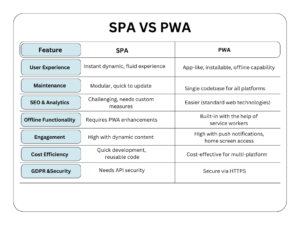Or maybe you’re mindlessly scrolling through Instagram during your lunch break, watching stories transition smoothly without a single page refresh. That’s a Single Page Application holding your attention.
Both PWAs and SPAs change how we use the web, but they tackle different issues. As we move through 2025, knowing when to use each approach can determine the success of your next project.
Stick around. We’re about to cover everything you need to know to make the right choice about Single Page Applications vs Progressive Web Applications.
What are Single Page Applications (SPAs)
SPA provides a modern way to build websites. Applications load once and then update their content smoothly without the need for a full-page refresh. Popular frameworks drive these applications, leading to experiences that feel natural and responsive. Users enjoy easy navigation while interacting with various features and sections.
Key SPA Features:
- Loads initial content once and then updates through JavaScript.
- Highly interactive, responsive, and intuitive user experience.
- Popular for data-driven apps and social feeds.
What is Progressive Web Applications (PWAs)?
Progressive Web Applications mix the best parts of websites and mobile apps into one experience. They use simple web tools like HTML, CSS, and JavaScript, but go beyond by letting you use them offline, receive push notifications, and even install them on your device. This means they feel like real apps, but you don’t need to visit an app store or worry about compatibility. Just open them in any browser and you’re good to go.
Key PWA Features:
- Works offline and sends push notifications.
- Installs on devices for app-like interactions.
- Universal browser compatibility; no app store required.
Market Trends & Stats: SPA vs PWA

Interconnected Real-life Experiences of SPA and PWA
Starbucks
A major coffee ordering platform initially launched as a SPA, allowing users to browse products and customize orders seamlessly. However, network limitations and changing customer expectations drove the company to evolve their platform into a PWA. The transformation delivered remarkable results with orders doubling, web app size shrinking by 99.84%, and mobile engagement increasing significantly. Customers gained the ability to place orders while offline, with transactions processing automatically once connectivity restored.
A popular visual platform rebuilt their mobile web as a PWA, witnessing core engagement increase by 60%, time spent rise by 40%, and ad revenue grow by 44%. The SPA interface delivers rich, uninterrupted discovery experiences, with PWA features extending functionality even during offline periods.
Interconnecting the Flow: Where SPA meets PWA
While SPA excels at creating dynamic, interactive platforms, PWA takes user expectations to the next level by delivering native app experiences. This becomes crucial when retention, speed, and accessibility determine success or failure.
Most modern applications begin their journey as SPAs, leveraging their speed and seamless navigation capabilities. As these platforms mature, developers often evolve them into PWAs to achieve broader device compatibility and enhanced user engagement. Technologies like Service Workers and Web App Manifests, fundamental to PWA development, are increasingly being integrated into existing SPA projects. This creates powerful hybrid solutions that combine real time user experiences with offline functionality and installation capabilities.
Why Do Developers Combine SPA and PWA?
- Performance Boosts: PWAs can cache SPA assets, ensuring lightning fast load times
- Offline Support: Service Worker integration allows SPAs to function in low connectivity environments
- Push Notifications: Essential for engagement, PWAs offer these while SPAs alone cannot
- SEO Optimization: PWAs, using server side rendering with SPA frameworks, improve search visibility
SPA vs PWA

Market Adoption of SPA vs PWA
SPA
Most web applications and medium-sized businesses have embraced SPA architecture, and this trend shows no signs of slowing through 2025. The emergence of serverless architectures and WebAssembly continues to enhance SPA scalability and performance capabilities. Companies appreciate the rapid deployment and update cycles that SPAs enable, making them the logical choice for software platforms, social networks, project management solutions, and commerce backends.
PWA
PWAs are positioned to fundamentally disrupt traditional app development approaches. Industry projections indicate the PWA market will reach $2.8 billion globally by 2025, maintaining a compound annual growth rate exceeding 30%. Businesses across retail, travel, and social media sectors are gravitating toward PWAs due to their cost-effectiveness, enhanced user engagement metrics, and seamless compatibility across devices. Industries that prioritize exceptional user experiences, particularly in markets with high mobile adoption rates, are implementing PWAs at an unprecedented pace.
The Human Side: Why It Actually Matters
User Engagement, Loyalty, and Accessibility
Let’s be honest about what users really want. We’re all busy, stressed, and frankly a little impatient. When someone opens an app, they’re not thinking about your brilliant code architecture. They’re thinking, “I need this to work right now, and I don’t have time for it to be slow or broken.”
People are checking things while walking between meetings, sitting in waiting rooms with spotty Wi-Fi, or lying in bed at 11 PM when their internet decides to take a nap. They want apps that just work, period. Whether they’re planning a trip, catching up on news, or obsessively tracking a package delivery, interruptions kill the mood completely.
Cost and Time to Market
Building separate apps for every platform is expensive and exhausting. You’re essentially paying different teams to solve the same problem multiple times.
Smart companies have figured out they can build once and reach everyone, everywhere. Your customers don’t care what technology you used. They just want your service to work perfectly whether they’re on their phone during lunch or their laptop at home.
Choosing the Right Strategy: SPA vs PWA
As we move deeper into 2025, the line between SPA and PWA continues to blur. Smart businesses choose a strategy that matches user needs:
- For rapid, highly interactive platforms (think dashboards, social feeds): Start with SPA.
- For wide reach and resilient engagement (think retail, hospitality, travel): Invest in PWA features for your SPA, or directly build a PWA.
Final Words
The winners are those who understand that technology should disappear into the background, creating digital experiences that feel effortless, accessible, and genuinely memorable for every person who uses them.
PWAs and SPAs become experience enablers that build loyalty, ensure accessibility, and deliver genuine satisfaction. Choose them based on the emotions you want to create, not just the performance metrics you want to hit.
Let Datafortune design the perfect solution that transforms casual visitors into passionate brand advocates. Contact us now!



